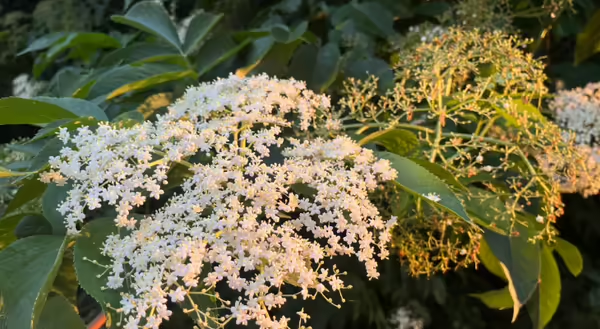
Most of the time, I work hard to achieve a desirable outcome in my landscape but, from time to time, a plant comes along that is easy to establish and care for without being too aggressive, is beautiful, and produces food for wildlife and my family…black elderberry is one of those plants.
Identification
Black or common elderberry (Sambucus nigra canadensis) is an attractive shrub that is well adapted to a wide range of site conditions. Tolerant of disturbed sites in full to part sun, Sambucus nigra canadensis can be found on the edges of woodlands, back slopes of roadside ditches, unmanaged windbreaks and other ‘wild’ spaces in our communities.
Black elderberry is a deciduous, multi-stemmed shrub ranging in size from four to twelve feet in height and spread. Young bark is light grayish brown with yellow tones, and mature wood darkens to a deep gray. New and old wood have numerous lenticels, small pore structures that facilitate gas exchange, which become more prominent over time.
Simple, pinnately compound leaves have five to nine leaflets and are arranged in an opposite pattern on the stem. Leaflets are an elongated shape described as lanceolate with serrated leaf margins. Some sources have compared the leaves to those of walnut (Juglans spp.) or ash (Fraxinus spp.). Leaves can be up to twelve inches in length and nearly as wide.
In early summer, large umbel flowers develop on the terminus of stems. Hundreds of small creamy-white flower clusters create an attractive floral display that can grow to nearly a foot in diameter. Blooms produce a sweet, slightly musky fragrance during their three-to-four-week bloom period.
Flowers are capable of self-pollination and develop into deep purple to black droop-like fruit later in the summer. Each droop contains three to five small seeds. Propagation is possible through seed dispersal, from root cuttings, or dormant cuttings.
Wildlife support
Elderberry is an essential component of the native wildlife ecosystem, providing nutrition and habitat.
The flowers of elderberry produce only pollen, thus limiting the appeal to insects. Bees, flies, and beetles utilize the plant as a food source, including honeybees, small carpenter bees, halictid bees, syrphid flies, tumbling flower beetles, scarab beetles, and more. The soft pith of the stems provides a nesting opportunity for carpenter bees. Leaves are consumed by a variety of larvae of several previously mentioned insects, but are consumed much less by mammals due to the toxic properties of the foliage.
Perhaps the most significant contribution made by the elderberry to native fauna is the berries produced in late summer. Birds large (turkey, pheasant, quail, etc.) and small (cedar waxwing, cardinal, eastern bluebird, robin, etc.) eagerly consume the ripe fruit.
Human use
Indigenous people have utilized elderberry for centuries – harvesting berries for nutrition, utilizing hollow stems for tools and instruments, and other plant parts for medicinal uses. It must be noted that without proper processing, the leaves, stems, and roots of elderberry can be toxic.
Only the dark blue to purple fruit of Sambucus nigra canadensis are considered safe for human consumption and should be processed before ingestion. To process, cook ripe fruits to break down toxins that remain from fruit development.
Once cooked, elderberries can be dried whole or used to make pies, jams and jellies, syrup, wine, and more. Elderberries are highly perishable, so whole fruit is unavailable commercially, but dried elderberry and elderberry products have gained popularity in recent years. There are products available that claim to provide a myriad of health benefits. And while there is emerging research that suggests measurable health benefits can be achieved through the use of elderberry products, further research is needed.
Good Growing Fact of the Week: Black elderberry is found throughout Illinois, while red elderberry (Sambucus racemosa) has been found in northern Illinois and is regarded as being uncommon. Red elderberry is smaller in size and produces bright red fruit. These fruits are toxic and should not be consumed.
Bonus Good Growing Fact of the Week: Black elderberry was once considered a distinct species and referred to as Sambucus canadensis but is now accepted as a subspecies of a European shrub Sambucus nigra nigra.
Thank you for reading!
Sign up for our emails! Want to get notified when new Good Growing posts are available? SIGN ME UP
Give us feedback! How helpful was this information (click one): Very helpful | Somewhat helpful | Not very helpful
MEET THE AUTHOR
Emily Swihart is a horticulture educator with University of Illinois Extension, serving Henry, Mercer, Rock Island, and Stark counties since 2021. Emily provides horticulture programming with an emphasis on the home gardener, the urban forest, native plant ecosystems, and landscape design. Additional responsibilities include supporting local county Master Gardener and Master Naturalist volunteers - providing training, continuing education, advanced training, and their involvement in seasonal events and community outreach programs.